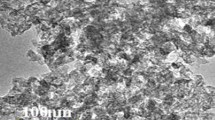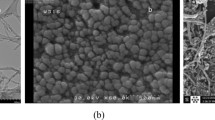Abstract
Hybrid nanofluids have better thermal conductivity and heat transfer properties than common fluids and currently have good prospects for applications in enhanced geothermal development. In this paper, a convective heat transfer experimental platform was built independently to study the convective heat transfer capability of Al2O3–SiO2/water hybrid nanofluid. The effect of different parameters on the enhanced heat transfer capability of the hybrid nanofluid was investigated, and the stability of the hybrid nanofluid under flow heat transfer conditions was evaluated. The following research results were obtained. Compared to water and single nanofluid, Al2O3–SiO2/water hybrid nanofluid has better enhanced heat transfer capability. The coaxial casing with "outside in and inside out" is more energy-efficient compared with the U-shaped heat exchanger tube. For Al2O3–SiO2/water hybrid nanofluid, there was an optimal particle concentration and ratio to optimize the convective heat transfer capability: a particle concentration of 0.10 wt % and a particle ratio of 5:5. The heat extraction of the fluid was negatively correlated with the inlet temperature and positively correlated with the flow rate. However, after the flow rate was higher than a certain extent, the heat exchange energy efficiency dropped significantly. The stability of Al2O3–SiO2/water hybrid nanofluid was well maintained in the flow heat exchange process. And the higher the flow rate, the more stable the particles are. However, the enhancement effect of macroscopic flow on the particle suspension stability would be weakened by too high fluid temperature.























Similar content being viewed by others
Data Availability
The datasets generated during and/or analysed during the current study are available from the corresponding author on reasonable request.
References
P. Sivashanmugam, Application of nanofluids in heat transfer (Chap. 14), in An Overview of Heat Transfer Phenomena. ed. by S.N. Kazi (InTech, London, 2012)
J.A. Eastman, U.S. Choi, S. Li, L.J. Thompson, S. Lee, Enhanced thermal conductivity through the development of nanofluids. MRS Proc. 457, 3 (1996). https://doi.org/10.1557/PROC-457-3
S.U.S. Choi, Z.G. Zhang, W. Yu, F.E. Lockwood, E.A. Grulke, Anomalous thermal conductivity enhancement in nanotube suspensions. Appl. Phys. Lett. 79, 14 (2001). https://doi.org/10.1063/1.1408272
C.H. Chon, S.W. Paik, J.B. Tipton Jr., K.D. Kihm, Evaporation and dryout of nanofluid droplets on a microheater array. J. Heat Transfer 128, 735 (2006). https://doi.org/10.1115/1.2221298
J.A. Eastman, S.U.S. Choi, S. Li, W. Yu, L.J. Thompson, Anomalously increased effective thermal conductivities of ethylene glycol-based nanofluids containing copper nanoparticles. Appl. Phys. Lett. 78, 6 (2001). https://doi.org/10.1063/1.1341218
N.S. Mane, V. Hemadri, Experimental investigation of stability, properties and thermo-rheological behaviour of water-based hybrid CuO and Fe3O4 nanofluids. Int. J. Thermophys. 43, 7 (2021). https://doi.org/10.1007/s10765-021-02938-2
K. Martin, A. Sözen, E. Çiftçi, H.M. Ali, An experimental investigation on aqueous Fe–CuO hybrid nanofluid usage in a plain heat pipe. Int. J. Thermophys. 41, 135 (2020). https://doi.org/10.1007/s10765-020-02716-6
S. Ferrouillat, A. Bontemps, O. Poncelet, O. Soriano, J.-A. Gruss, Influence of nanoparticle shape factor on convective heat transfer and energetic performance of water-based SiO2 and ZnO nanofluids. Appl. Therm. Eng. 51, 1–2 (2013). https://doi.org/10.1016/j.applthermaleng.2012.10.020
M. Alishiri, A. Akbari, M.H. Saidi, Thermal performance of a pulsating heat pipe charged with Fe3O4-MWCNTs/DI water hybrid nanofluid: Experimental study and optimization. J. Therm. Anal. Calorim. 147, 23 (2022). https://doi.org/10.1007/s10973-022-11517-y
S. Mukherjee, S.R. Panda, P.C. Mishra, P. Chaudhuri, Enhancing thermophysical characteristics and heat transfer potential of TiO2/water nanofluid. Int. J. Thermophys. 41, 162 (2020). https://doi.org/10.1007/s10765-020-02745-1
R.J. Issa, A review on thermophysical properties and nusselt number behavior of Al2O3 nanofluids in heat exchangers. J. Therm. Sci. 30, 2 (2021). https://doi.org/10.1007/s11630-021-1266-1
H. Tarigonda, D.P.M.D. Shaik, D.R.R. Reddy, G.V.S. Reddy, Experimental investigation on the heat pipe using Al2O3 and CuO hybrid nanofluid. Int. J. Thermophys. 43, 153 (2022). https://doi.org/10.1007/s10765-022-03078-x
S. Mukherjee, S.R. Panda, P.C. Mishra, P. Chaudhuri, Convective flow boiling heat transfer enhancement with aqueous Al2O3 and TiO2 nanofluids: experimental investigation. Int. J. Thermophys. 42, 88 (2021). https://doi.org/10.1007/s10765-021-02850-9
B. Sahin, G.G. Gültekin, E. Manay, S. Karagoz, Experimental investigation of heat transfer and pressure drop characteristics of Al2O3–water nanofluid. Exp. Therm. Fluid Sci. (2013). https://doi.org/10.1016/j.expthermflusci.2013.04.020
D. Huang, Z. Wu, B. Sunden, Effects of hybrid nanofluid mixture in plate heat exchangers. Exp. Therm. Fluid Sci. (2016). https://doi.org/10.1016/j.expthermflusci.2015.11.009
B.A.K. Naik, A.V. Vinod, Heat transfer enhancement using non-Newtonian nanofluids in a shell and helical coil heat exchanger. Exp. Therm. Fluid Sci. (2018). https://doi.org/10.1016/j.expthermflusci.2017.09.013
R. Gangadevi, B.K. Vinayagam, Experimental determination of thermal conductivity and viscosity of different nanofluids and its effect on a hybrid solar collector. J. Therm. Anal. Calorim. 136, 1 (2019). https://doi.org/10.1007/s10973-018-7840-4
W. Urmi, M.M. Rahman, W.A.W. Hamzah, An experimental investigation on the thermophysical properties of 40 % ethylene glycol based TiO2-Al2O3 hybrid nanofluids. Int. Commun. Heat Mass Transf. (2020). https://doi.org/10.1016/j.icheatmasstransfer.2020.104663
V.V. Wanatasanappan, M.Z. Abdullah, P. Gunnasegaran, Thermophysical properties of Al2O3–CuO hybrid nanofluid at different nanoparticle mixture ratio: an experimental approach. J. Mol. Liq. (2020). https://doi.org/10.1016/j.molliq.2020.113458
V.V. Wanatasanapan, M.Z. Abdullah, P. Gunnasegaran, Effect of TiO2-Al2O3 nanoparticle mixing ratio on the thermal conductivity, rheological properties, and dynamic viscosity of water-based hybrid nanofluid. J. Mater. Res. Technol. 9, 6 (2020). https://doi.org/10.1016/j.jmrt.2020.09.127
N.N.M. Zawawi, W.H. Azmi, M.Z. Sharif, G. Najafi, Experimental investigation on stability and thermo-physical properties of Al2O3–SiO2/PAG nanolubricants with different nanoparticle ratios. J. Therm. Anal. Calorim. 135, 2 (2019). https://doi.org/10.1007/s10973-018-7670-4
B. Xiao, Y. Yang, L. Chen, Developing a novel form of thermal conductivity of nanofluids with Brownian motion effect by means of fractal geometry. Powder Technol. (2013). https://doi.org/10.1016/j.powtec.2013.02.029
S.M.S. Murshed, K.C. Leong, C. Yang, A combined model for the effective thermal conductivity of nanofluids. Appl. Therm. Eng. 29, 11–12 (2009). https://doi.org/10.1016/j.applthermaleng.2008.12.018
S.P. Jang, S.U.S. Choi, Role of Brownian motion in the enhanced thermal conductivity of nanofluids. Appl. Phys. Lett. 84, 21 (2004). https://doi.org/10.1063/1.1756684
L. Megatif, A. Ghozatloo, A. Arimi, M. Shariati-Niasar, Investigation of laminar convective heat transfer of a novel TiO2–carbon nanotube hybrid water-based nanofluid. Exp. Heat Transf. 29, 1 (2016). https://doi.org/10.1080/08916152.2014.973974
A.A. Minea, Hybrid nanofluids based on Al2O3, TiO2 and SiO2: numerical evaluation of different approaches. Int. J. Heat Mass Transf. (2017). https://doi.org/10.1016/j.ijheatmasstransfer.2016.09.012
Y. Shin, J. Ham, T. Boldoo, H. Cho, Magnetic effect on the enhancement of photo-thermal energy conversion efficiency of MWCNT/Fe3O4 hybrid nanofluid. Sol. Energy Mater. Sol. Cells (2020). https://doi.org/10.1016/j.solmat.2020.110635
O.A. Hussein, K. Habib, A.S. Muhsan, R. Saidur, O.A. Alawi, T.K. Ibrahim, Thermal performance enhancement of a flat plate solar collector using hybrid nanofluid. Sol. Energy (2020). https://doi.org/10.1016/j.solener.2020.04.034
T. Sivasakthivel, K. Murugesan, S. Kumar, P. Hu, P. Kobiga, Experimental study of thermal performance of a ground source heat pump system installed in a Himalayan city of India for composite climatic conditions. Energy Build. (2016). https://doi.org/10.1016/j.enbuild.2016.09.034
M. Habibi, A. Hakkaki-Fard, Long-term energy and exergy analysis of heat pumps with different types of ground and air heat exchangers. Int. J. Refrig. (2019). https://doi.org/10.1016/j.ijrefrig.2019.02.021
Y. Shi. Study on heat extraction rate of a deep underground heat exchanger (2018). https://doi.org/10.27356/d.cnki.gtjdu.2018.002050.
A.K. Gupta, B. Gupta, J. Bhalavi, P. Baredar, H. Parmar, R. Senthil, CFD study on heat transfer and pressure drop of nanofluids(SiO2/H2O, Al2O3/H2O, CNTs/H2O) in a concentric tube heat exchanger. Int. J. Ambient Energy 43, 1 (2022). https://doi.org/10.1080/01430750.2021.1913222
H. Li, X. Wang, Y. Li, X. Wen, Y. Hu, Effect of particle concentration on the flocculation and sedimentation of unstable Al2O3–SiO2/water hybrid nanofluid. J. Nanopart. Res. 24, 263 (2022). https://doi.org/10.1007/s11051-022-05639-5
Funding
This study is supported by the National Natural Science Foundation of China (Grant No. 52074194).
Author information
Authors and Affiliations
Contributions
All authors contributed to the study conception and design. Material preparation, data collection and analysis were performed by YH, HL and JH. The first draft of the manuscript was written by YX and all authors commented on previous versions of the manuscript. All authors read and approved the final manuscript.
Corresponding author
Ethics declarations
Conflict of interest
The authors declare no competing interests.
Additional information
Publisher's Note
Springer Nature remains neutral with regard to jurisdictional claims in published maps and institutional affiliations.
Rights and permissions
Springer Nature or its licensor (e.g. a society or other partner) holds exclusive rights to this article under a publishing agreement with the author(s) or other rightsholder(s); author self-archiving of the accepted manuscript version of this article is solely governed by the terms of such publishing agreement and applicable law.
About this article
Cite this article
Huang, Y., Li, H., Hu, J. et al. Study on Enhanced Heat Transfer and Stability Characteristics of Al2O3–SiO2/Water Hybrid Nanofluids. Int J Thermophys 44, 156 (2023). https://doi.org/10.1007/s10765-023-03262-7
Received:
Accepted:
Published:
DOI: https://doi.org/10.1007/s10765-023-03262-7




